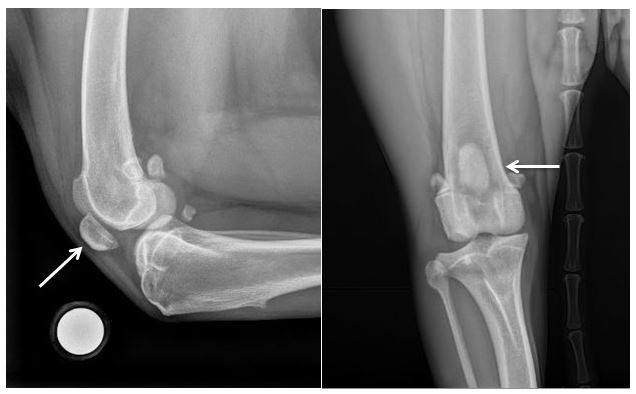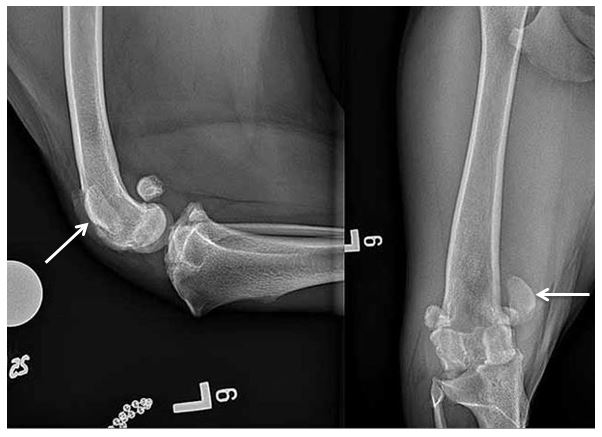Patellar Luxation
by Angelia Oliverei, LVT
What is a “luxating patella”?
Patellar luxation is a condition that occurs in dogs and cats in which the patella (kneecap) slides out its normal position (see radiographs below). The patella is a sesamoid bone, which means it is a bone embedded in soft tissue that serves as an anchor point for muscle during movement. The patella is located in the trochlear groove of the femur and is held in position by the patella ligament that attaches to the quadriceps muscles and ends with its insertion at the front of the tibia. Patella luxation can occur when the trochlear groove is too shallow, not allowing the patella to sit properly within the groove. It can luxate medially (towards the inside of the leg) or laterally (towards the outside of the leg), but medial luxation is more common. Additionally, the patella can luxate because the ligament that holds the patella in position within the grove is attached too far medially. When the thigh muscle contracts, it will pull the patella out of its groove. Patella luxation most commonly affects small breed dogs including Yorkshire Terriers, Chihuahuas, Boston Terriers, Bulldogs, Pomeranians, and miniature Poodles. However, it can affect large breed dogs and cats.
Grades of Patella luxation:
The severity of patellar luxation is graded. This allows veterinary professionals to discuss the pet’s medical condition easily.
- Grade ¼ = the patella can be luxated manually but returns to its normal position.
- Grade 2/4 = the patella can be luxated manually, and will stay in that position until it is manually replaced.
- Grade ¾ = the patella remains out most of the time. It can be manually placed back into normal position but will luxate back out.
- Grade 4/4 = the patella is luxated and cannot be manually placed back into normal position.
Symptoms
Depending on the grade of luxation, animals suffering from a patella luxation may or may not show signs of discomfort. The most common sign is decreased to minimal weight bearing on the limb. There are many affected animals that will learn how to put the patella back into position themselves by hyper extending the leg (appears like a skip in motion), which snaps the patella back into position.
Long Term Care
Patella luxation can cause arthritic changes over time due to abnormal movement within the joint and this can lead to discomfort and progression of arthritis. Rehabilitation therapy uses targeted structured exercises to help strengthen the muscles that surround the joint with the intent to minimize luxation of the patella. There are surgical options available to patients suffering from patella luxation. Surgical correction is usually recommended in patients with grades 3-4 patella luxation. The most common surgical corrections include Lateral Imbrication, Medial Release, Trochleoplasty, and Tibial Tuberosity Transposition. Regardless of the surgery performed, post-operative rehabilitation is typically recommended. Rehabilitation will help promote normal function of the joint by increasing muscle mass and improving balance.


The radiographs on the left show the patella in a normal position. On the right we have radiographs that show a medial patellar luxation.
